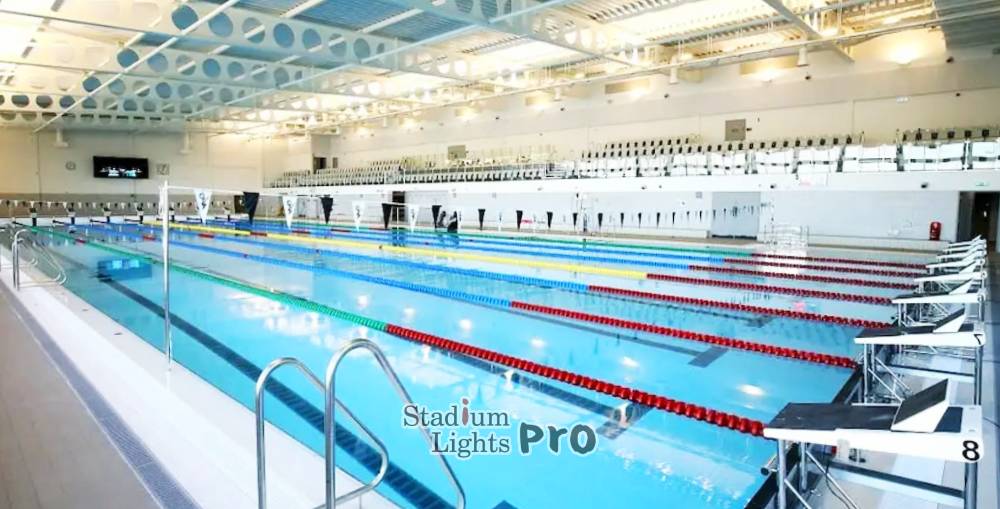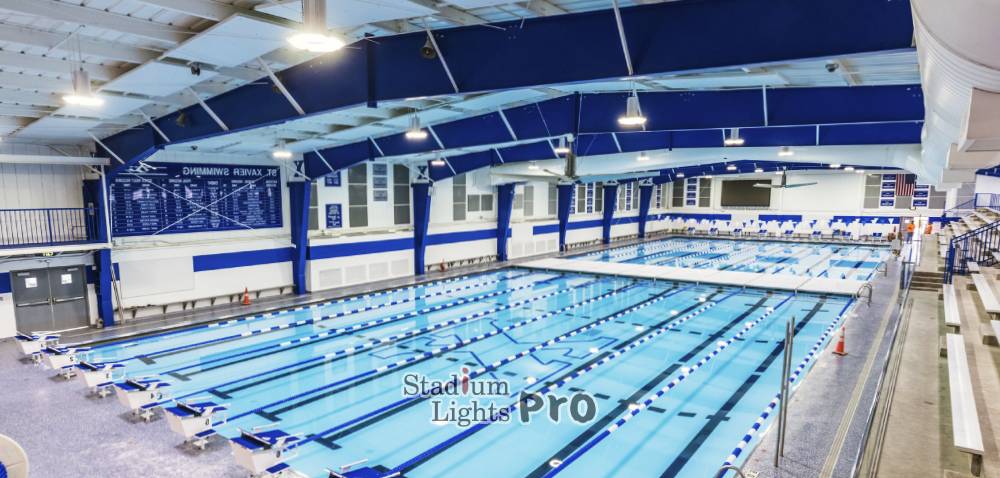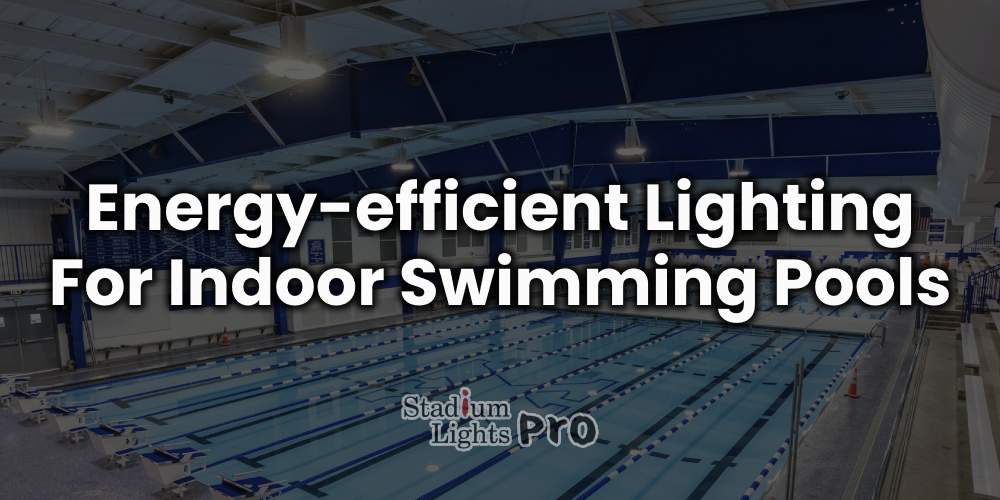In the realm of indoor swimming pools, the choice of lighting transcends mere illumination—it becomes a pivotal decision intertwining sustainability, economics, and safety. Understanding the significance of energy-efficient lighting in this context unveils a multifaceted array of benefits.
Table of Contents
ToggleImportance of Energy-Efficient Lighting
Embracing energy-efficient lighting solutions not only aligns with contemporary environmental imperatives but also yields tangible economic advantages. By reducing energy consumption, these lighting systems contribute to mitigating carbon footprints and promoting ecological stewardship. Moreover, the financial dividends of energy efficiency are profound, as lower energy bills translate into substantial cost savings over time. Yet, beyond fiscal prudence and environmental responsibility, energy-efficient lighting augments the ambiance and safety of indoor swimming pools. Through optimal illumination levels and enhanced visual clarity, it fosters an inviting and secure environment for swimmers and spectators alike. Thus, the quest for energy efficiency in indoor pool lighting converges at the nexus of environmental sustainability, economic prudence, and user well-being.
Understanding Energy Efficiency
Energy Efficiency Basics
At its core, energy efficiency denotes the maximization of output relative to input, emphasizing the optimization of resources to accomplish a given task. In the context of lighting, energy efficiency entails producing adequate illumination while minimizing power consumption. Key concepts include luminous efficacy (the amount of visible light emitted per unit of electrical power) and color rendering index (CRI), which measures a light source’s ability to accurately render colors.
Importance in Indoor Pool Environments
In indoor pool environments, energy efficiency assumes heightened significance due to continuous operation and high lighting requirements. Efficient lighting not only reduces operational costs but also contributes to environmental sustainability by curbing energy consumption and greenhouse gas emissions. Moreover, in settings where safety and visual clarity are paramount, energy-efficient lighting ensures optimal illumination levels without compromising on efficacy.

Types of Energy-Efficient Lighting
LED
Light Emitting Diode (LED) lighting has emerged as a leading energy-efficient solution for indoor pools. LED fixtures offer superior energy efficiency, longevity, and versatility in color temperature options. Their durability, instant-on capability, and resistance to temperature fluctuations make them ideal for challenging indoor pool environments.
CFL
Compact Fluorescent Lamp (CFL) lighting represents another energy-efficient option, characterized by its spiral or tubular design. While CFLs provide significant energy savings compared to traditional incandescent bulbs, they may exhibit limitations in terms of color rendering and disposal due to their mercury content.
Halogen Incandescents
Halogen incandescent bulbs, although more efficient than standard incandescents, have largely been overshadowed by LED and CFL alternatives. While they offer improved efficacy and color rendering, their shorter lifespan and higher operating temperatures make them less favorable for energy-conscious indoor pool lighting applications.
Assessing Lighting Requirements
Pool Size and Shape
The size and shape of an indoor pool have a direct impact on lighting requirements. Larger pools necessitate more extensive lighting coverage to ensure uniform illumination across the surface area. Additionally, irregularly shaped pools may require strategic placement of fixtures to minimize shadows and ensure consistent light distribution.
Purpose of Lighting
Indoor pool lighting serves multiple purposes beyond mere visibility, each requiring specific considerations:
General Illumination
Providing overall brightness to the pool area for safety and navigational purposes. This requires uniform lighting distribution across the pool surface and surrounding areas.
Task Lighting
Targeted illumination for specific activities such as swimming lanes, poolside seating areas, or maintenance tasks. Task lighting should be adjustable and focused to meet specific needs without causing glare or distractions.
Accent Lighting
Enhancing the aesthetic appeal of the pool area through focal points, architectural features, or landscaping. Accent lighting adds ambiance and visual interest, but should be carefully integrated to avoid over-illumination or light pollution.
Safety and Compliance
Adherence to local regulations and safety standards is paramount in indoor pool environments:
Local Regulations: Compliance with building codes, electrical regulations, and safety ordinances ensures the legal operation and occupancy of indoor pools. This includes requirements for lighting fixtures, electrical wiring, and emergency lighting systems.
Waterproof and Corrosion-Resistant Fixtures: Given the high moisture and chemical exposure in indoor pool environments, lighting fixtures must be specifically designed for waterproofing and corrosion resistance. Fixtures should carry appropriate IP (Ingress Protection) ratings to withstand exposure to water, humidity, and pool chemicals without compromising performance or safety. Additionally, fixtures should be constructed from durable materials such as stainless steel or corrosion-resistant polymers to ensure longevity and reliability in harsh indoor pool conditions.

Comparing Lighting Options
LED Lights
LED lights are renowned for their longevity and durability, making them ideal for indoor pool environments. They boast an extended lifespan compared to traditional lighting sources, reducing maintenance costs and downtime. Moreover, LED lights are highly energy-efficient, translating a higher percentage of input energy into visible light, resulting in significant energy savings over time. Their versatility is evident in the wide range of color temperature options available, allowing customization to suit the desired ambiance and visual aesthetics of the indoor pool environment.
CFL Lights
Compact Fluorescent Lamp (CFL) lights offer energy efficiency and cost savings, albeit with certain considerations. While CFL bulbs consume significantly less energy than traditional incandescent bulbs, their efficiency may be slightly lower compared to LED lights. Despite their lower initial purchase cost, it’s important to consider long-term operating costs, including energy consumption and maintenance, to assess overall cost-effectiveness.
Halogen Incandescents
Halogen incandescent bulbs represent an improvement over traditional incandescents but have limitations. They produce bright, white light with excellent color rendering properties, making them suitable for indoor pool environments where visual clarity is essential. However, their brightness may be surpassed by LED lights, and their color rendering may not be as accurate. While more energy-efficient than traditional incandescents, halogen incandescent bulbs still consume more energy and have a shorter lifespan compared to LED lights, making them less preferable for long-term use in indoor pool lighting applications.
Evaluating Lighting Design
Lighting Placement
Strategic lighting placement is crucial for achieving optimal illumination in indoor pool environments. Ensuring even illumination across the pool surface and surrounding areas enhances visibility and safety for swimmers and spectators alike. Additionally, proper placement helps minimize shadows and glare, creating a comfortable and visually pleasing atmosphere.
Even Illumination
Uniform lighting distribution is essential to eliminate dark spots and ensure consistent brightness throughout the indoor pool area. Achieving even illumination requires careful positioning of lighting fixtures and selecting appropriate light sources with sufficient output and coverage.
Reducing Shadows and Glare
Minimizing shadows and glare enhances visibility and reduces eye strain in indoor pool environments. This can be achieved through thoughtful lighting design, including the use of diffusers, baffles, or directional fixtures to control light direction and intensity.
Reflectance and Surface Materials
The reflectance and surface materials of the pool and surrounding areas influence lighting design and effectiveness. Light-colored surfaces reflect more light, enhancing overall brightness, while dark surfaces absorb light, creating darker areas. Selecting pool materials with higher reflectance can improve lighting efficiency and visibility in indoor pool environments.
Impact of Pool Materials on Lighting
The type of pool materials used can affect lighting performance and aesthetics. Smooth and glossy surfaces, such as tiled or painted pool walls, reflect light more effectively than rough or textured surfaces, resulting in brighter and more uniform illumination. Additionally, transparent or translucent pool materials, such as glass tiles or acrylic panels, can create unique lighting effects and enhance the ambiance of the indoor pool area.
Control Systems
Implementing advanced control systems enhances flexibility and efficiency in indoor pool lighting:
Dimmers and Smart Controls
Dimmable lighting fixtures and smart control systems allow users to adjust light levels according to preference and activity. Dimmers enable precise control over brightness, while smart controls offer programmable settings and remote access for convenience and energy savings.
Motion Sensors and Timers
Motion sensors and timers automate lighting control based on occupancy and time of day, improving energy efficiency and security. Motion sensors detect movement and activate lighting only when needed, while timers schedule lighting operation according to preset times, reducing energy waste during off-peak hours.
Cost Considerations
Initial Costs vs. Long-term Savings
When evaluating indoor pool lighting options, it’s essential to consider both initial costs and long-term savings. While energy-efficient lighting solutions may have higher upfront costs compared to traditional alternatives, the potential for significant savings in energy consumption and maintenance expenses over time can outweigh the initial investment.
Purchase and Installation Costs
The initial purchase and installation costs of indoor pool lighting encompass the price of lighting fixtures, wiring, and labor. Energy-efficient lighting options such as LED fixtures may have higher upfront costs than traditional lighting sources like halogen incandescents or CFL bulbs. Additionally, installation expenses may vary depending on the complexity of the lighting system and the expertise required for installation.
Energy Savings Over Time
One of the primary advantages of energy-efficient lighting is its potential for long-term energy savings. LED lights, for example, consume significantly less energy than traditional lighting sources, resulting in lower electricity bills over their extended lifespan. While the initial investment in energy-efficient lighting may be higher, the ongoing energy savings can lead to substantial cost reductions over time, making them a more cost-effective option in the long run.
Maintenance and Replacement
The lifespan and maintenance requirements of different lighting types impact overall cost considerations:
Lifespan of Different Lighting Types
LED lights typically have a much longer lifespan than traditional lighting sources such as halogen incandescents or CFL bulbs. LED fixtures can last tens of thousands of hours, reducing the frequency of bulb replacements and associated maintenance costs. In contrast, halogen incandescent bulbs have a shorter lifespan and may require more frequent replacements, increasing long-term maintenance expenses.
Ease of Maintenance
Energy-efficient lighting options like LED fixtures often require less maintenance compared to traditional lighting sources. LED lights are highly durable and resistant to shock, vibration, and temperature fluctuations, minimizing the need for frequent replacements or repairs. Additionally, the sealed design of LED fixtures reduces the risk of moisture and debris ingress, further enhancing their reliability and ease of maintenance.
Practical Tips for Implementation
Choosing the Right Fixtures
Selecting appropriate lighting fixtures is essential for effective indoor pool lighting design. Consider fixtures with:
Waterproof Ratings (IP Ratings)
Choose fixtures with high IP ratings to ensure protection against water ingress and moisture damage in humid pool environments.
Corrosion Resistance: Opt for fixtures made from corrosion-resistant materials such as stainless steel or marine-grade aluminum to withstand exposure to pool chemicals and humidity.
Professional Consultation
Seeking professional advice from lighting designers and electricians can help ensure a successful lighting implementation. Professionals can offer valuable insights into:
Working with Lighting Designers and Electricians
Collaborate with experienced professionals who specialize in indoor pool lighting design and installation. They can help create customized lighting solutions tailored to your pool’s specific requirements and preferences.
Installation Best Practices
Adhering to installation best practices is crucial for the safety and longevity of indoor pool lighting systems. Follow these guidelines:
Ensuring Proper Wiring and Safety Measures: Hire qualified electricians to install lighting fixtures and wiring according to local electrical codes and safety standards. Proper wiring and grounding are essential to prevent electrical hazards and ensure reliable operation of the lighting system.
Case Studies and Examples
Successful Implementations
Exploring real-world examples of energy-efficient lighting in indoor pools can provide valuable insights and inspiration for your own project. Look for case studies showcasing:
Energy-Efficient Lighting Solutions
Innovative lighting technologies and design strategies have been successfully implemented in various indoor pool projects worldwide. These case studies highlight:
LED Lighting Solutions
Discover how LED fixtures have been utilized to enhance energy efficiency, durability, and visual aesthetics in indoor pool environments. Learn about the specific LED products used, their performance metrics, and the resulting benefits in terms of energy savings and user experience.
Integrated Control Systems
Explore case studies demonstrating the integration of advanced control systems, such as dimmers, smart controls, motion sensors, and timers, to optimize energy efficiency and user comfort in indoor pool lighting. Understand how these control systems are configured and programmed to adjust lighting levels based on occupancy, time of day, and user preferences.
Lessons Learned and Best Practices
Learning from the experiences of others can provide valuable insights into the challenges, solutions, and best practices associated with indoor pool lighting projects. These case studies offer:
Challenges Faced
Gain an understanding of the common challenges encountered during indoor pool lighting projects, such as regulatory compliance, budget constraints, and technical limitations. Explore how these challenges were addressed and overcome through innovative solutions and collaboration with industry professionals.
Solutions Implemented
Discover the specific lighting solutions and design approaches employed to address the unique requirements and constraints of indoor pool environments. Learn about the selection of lighting fixtures, control systems, and installation techniques used to achieve optimal lighting performance, energy efficiency, and user satisfaction.
Key Takeaways for Future Projects
Extract valuable lessons and best practices from successful indoor pool lighting projects to inform and guide future endeavors. Identify opportunities for improvement, areas of innovation, and strategies for maximizing the benefits of energy-efficient lighting in indoor pool environments.
Conclusion
The journey towards energy-efficient lighting for indoor swimming pools underscores its paramount importance across multiple dimensions. From mitigating operational costs and environmental footprints to amplifying safety and aesthetics, the benefits are manifold. We’ve traversed essential steps in navigating the selection process, recognizing the need to assess lighting requirements, compare options, and evaluate design considerations. Prioritizing energy efficiency, safety, and visual appeal ensures the creation of sustainable, inviting spaces that optimize user experience.

